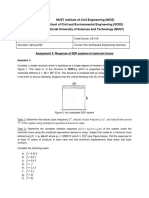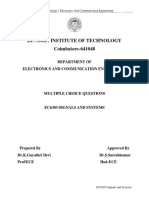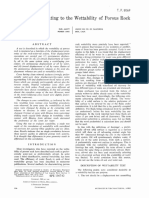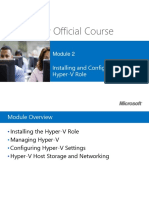Obj Unit I
Uploaded by
ramadharanObj Unit I
Uploaded by
ramadharanU07CE702 Basics of Dynamics and Aseismic Design - Unit I
KUMARAGURU COLLEGE OF TECHNOLOGY, COIMBATORE-6
(An Autonomous Institution affiliated to Anna University of Technology, Coimbatore)
DEPARTMENT OF CIVIL ENGINEERING
Objective type Questions & Answers
Concept of inertia and damping – Types of Damping – Difference between static forces and
dynamic excitation – Degrees of freedom – SDOF idealisation – Equations of motion of SDOF
system for mass as well as base excitation – Free vibration of SDOF system – Response to
harmonic excitation – Impulse and response to unit impulse – Duhamel integral
1. The maximum displacement or deformation of a vibrating system from its mean position is called
as,
a) Amplitude b) Deformation c) Damping d) Frequency
2. The unit for linear frequency is expressed by,
a) Cps b) Hz c) rad/sec d) both a & b
3. Periodic loads are ____________________ in nature.
a) Longer c) Complex c) Repetitive d) Virtual
4. The equation for a damped SDOF system subjected to free vibration is,
a) mx¨ + c x˙ + ω n2 x = 0 b) mx¨ + c x˙ + = 0
b) mx¨ + c x˙ + ω n2 x = F(t) d) mx¨ + ω n2 x = F(t)
5. The expression for equivalent stiffness for two springs connected in series is,
a) 1/ Ke = 1/K1 + 1/K2 b) Ke = K1 + K2
b) Ke = K1+K2/(K1 K2) d) 1/Ke = K1 + K2
6. The spring factor for a cantilever beam subjected to a point load at its free end is,
a) 48EI/l3 b) l3/48EI c) 5wl3/384EI d) 3EI/l3
7. If damping ratio α =1, the system is said to be
a) Undamped b) damped c) Critically damped d) Nil
8. When the frequency of the applied loading matches the undamped natural frequency of the
system, the system is said to be
a) Resonant b) Harmonic c) Non-harmonic d) At rest
9. The vibration which is maintained in a structure by steady periodic force acting on the structure is
known as
a) Free vibration b) Forced vibration c) Undamped vibration b) both a & b
10. The frequency ratio is expressed by,
a) β = ω /ω n b) β = ω n/ω c) β = ω . ω n d) β = f/ω n
Prepared by MS. K.Ramadevi, Senior Lecturer/ Civil Engg, KCT Page 1
U07CE702 Basics of Dynamics and Aseismic Design - Unit I
Ans: 1. a) 2. d) 3. c) 4. a) 5. a) 6. d) 7. c) 8. a) 9. b) 10. a)
Prepared by MS. K.Ramadevi, Senior Lecturer/ Civil Engg, KCT Page 2
You might also like
- Rajiv Gandhi University of Knowledge Technologies: (Department Ofmechanical Engineering) Weekly Test - 4No ratings yetRajiv Gandhi University of Knowledge Technologies: (Department Ofmechanical Engineering) Weekly Test - 43 pages
- Btech Ee 8 Sem Power System Dynamics and Control 2010No ratings yetBtech Ee 8 Sem Power System Dynamics and Control 20107 pages
- Btech Ee 8 Sem Power System Dynamics and Control 2012No ratings yetBtech Ee 8 Sem Power System Dynamics and Control 20124 pages
- Dream: If The Roots of This Equation Are Real, Then The System Will Be A) Over DampedNo ratings yetDream: If The Roots of This Equation Are Real, Then The System Will Be A) Over Damped2 pages
- Shock Response Spectrum Testing For Commercial Products (Tom Irvine) SRS NcodeNo ratings yetShock Response Spectrum Testing For Commercial Products (Tom Irvine) SRS Ncode9 pages
- Btech Ee 8 Sem Power System Dynamics and Control s3 2011No ratings yetBtech Ee 8 Sem Power System Dynamics and Control s3 20114 pages
- Optimization of Sti Ffness and Damping For Multi-Storey StructuresNo ratings yetOptimization of Sti Ffness and Damping For Multi-Storey Structures8 pages
- HT TP: //qpa Pe R.W But .Ac .In: CS / B.TECH (FT) / SEM-6 / ET-601/ 2011No ratings yetHT TP: //qpa Pe R.W But .Ac .In: CS / B.TECH (FT) / SEM-6 / ET-601/ 20117 pages
- St. Joseph's College of Engineering, Chennai-119 Department of Mechanical Engineering Sub. Name: Dynamics of Machinery Sub - Code: ME2302No ratings yetSt. Joseph's College of Engineering, Chennai-119 Department of Mechanical Engineering Sub. Name: Dynamics of Machinery Sub - Code: ME23027 pages
- Btech Ece 3 Sem Circuit Theory and Networks 2010No ratings yetBtech Ece 3 Sem Circuit Theory and Networks 20108 pages
- Noise and Vibration: MCQ: "Vibratory Motion"100% (2)Noise and Vibration: MCQ: "Vibratory Motion"148 pages
- Dire Dawa University: Department of Civil Engineering100% (1)Dire Dawa University: Department of Civil Engineering3 pages
- WWW - Manare S U Lts - Co.In: Structural DynamicsNo ratings yetWWW - Manare S U Lts - Co.In: Structural Dynamics2 pages
- Quiz No.1: (C) Flash-Over of InsulatorsNo ratings yetQuiz No.1: (C) Flash-Over of Insulators32 pages
- The System Shown To The Right Is Subject To Base Excitation. 3.00N/m, K 12.00N/mNo ratings yetThe System Shown To The Right Is Subject To Base Excitation. 3.00N/m, K 12.00N/m1 page
- Closed-Loop Frequency Response - Control Systems Questions and AnswersNo ratings yetClosed-Loop Frequency Response - Control Systems Questions and Answers4 pages
- Microwave Engineering: Time Allotted: 3 Hrs Full Marks: 70No ratings yetMicrowave Engineering: Time Allotted: 3 Hrs Full Marks: 705 pages
- Signals and Systems Multiple Choice Questions100% (9)Signals and Systems Multiple Choice Questions7 pages
- 300480 (Final)_Dynamics_Mechanical_SystemsNo ratings yet300480 (Final)_Dynamics_Mechanical_Systems4 pages
- btech-ce-6-sem-structural-dynamics-and-earthquake-engineering-2013No ratings yetbtech-ce-6-sem-structural-dynamics-and-earthquake-engineering-20137 pages
- Control Systems Questions and Answers For Experienced0% (1)Control Systems Questions and Answers For Experienced5 pages
- Mathematical and Computational Modeling: With Applications in Natural and Social Sciences, Engineering, and the ArtsFrom EverandMathematical and Computational Modeling: With Applications in Natural and Social Sciences, Engineering, and the ArtsRoderick MelnikNo ratings yet
- SPE-1167-Wettability of Porous Rock by Amott, 1960)No ratings yetSPE-1167-Wettability of Porous Rock by Amott, 1960)7 pages
- What Is Fact?: A Fact Is A Collection of Related Data Items, Each Fact Typically Represents A Business Item, ANo ratings yetWhat Is Fact?: A Fact Is A Collection of Related Data Items, Each Fact Typically Represents A Business Item, A28 pages
- Crate Conditioning of Bongo (Tragelaphus Eurycerus) For Veterinary and Husbandry Procedures at The Denver Zoological GardensNo ratings yetCrate Conditioning of Bongo (Tragelaphus Eurycerus) For Veterinary and Husbandry Procedures at The Denver Zoological Gardens8 pages
- 7SA522 Data Sheet For Setting Calculation Data Description Name of The Line General System and Sub-Station Data Value UnitNo ratings yet7SA522 Data Sheet For Setting Calculation Data Description Name of The Line General System and Sub-Station Data Value Unit1 page
- Microsoft Official Course: Installing and Configuring The Hyper-V RoleNo ratings yetMicrosoft Official Course: Installing and Configuring The Hyper-V Role43 pages
- Quay Et Al (2022) Dewey's Education Through Occupations As Being-Doing-Knowing Creative Learning UnitsNo ratings yetQuay Et Al (2022) Dewey's Education Through Occupations As Being-Doing-Knowing Creative Learning Units17 pages
- Ta25du2.4 Ta25du3.1 Ta25du32 Ta25du11 Ta25du14 Ta25du4.0 Ta25du1.8 Ta25du25No ratings yetTa25du2.4 Ta25du3.1 Ta25du32 Ta25du11 Ta25du14 Ta25du4.0 Ta25du1.8 Ta25du258 pages
- Example of A Dissertation Problem Statement100% (1)Example of A Dissertation Problem Statement8 pages
- Instruction Manual: Autoclaves & SterilizersNo ratings yetInstruction Manual: Autoclaves & Sterilizers61 pages
- ELYM 115 2nd Opp Examination MC-2022-09-21 TTNo ratings yetELYM 115 2nd Opp Examination MC-2022-09-21 TT3 pages
- Lake Milton Hydroelectric Project: Mahoning Hydropower, LLC100% (1)Lake Milton Hydroelectric Project: Mahoning Hydropower, LLC77 pages
- Integration of Git Java and Maven To JenkinsNo ratings yetIntegration of Git Java and Maven To Jenkins2 pages
- J40-922 Issue 01.1 - Cabri G2 Flight Manual Supplement - LH Chin Window Mount For External EquipmentNo ratings yetJ40-922 Issue 01.1 - Cabri G2 Flight Manual Supplement - LH Chin Window Mount For External Equipment4 pages
- 042 M8 A-Code Female Connector, Molded Cable, EMI-Shielded, Free EndNo ratings yet042 M8 A-Code Female Connector, Molded Cable, EMI-Shielded, Free End1 page

























































































